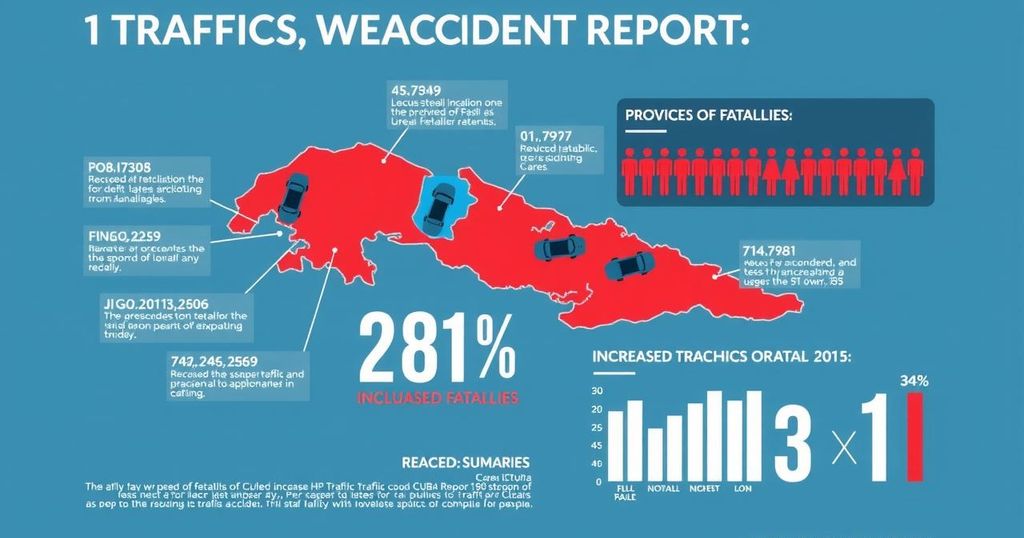Traffic Fatalities Rise in Cuba Despite Fewer Accidents in Early 2025
Cuba reports increased traffic fatalities despite fewer accidents. In Q1 2025, 1,738 accidents occurred, leading to 173 deaths, up from 146 in 2024. The issue persists across several provinces with ongoing infrastructure challenges. The government acknowledges the need for improved safety measures but relies on human factors as primary causes, neglecting serious structural problems.
In a concerning trend, Cuba has reported an uptick in traffic-related fatalities during the first quarter of 2025, even as overall traffic incidents dropped. Data shared by the Minister of Transport, Eduardo Rodríguez Dávila, reveals there were 1,738 accidents recorded from January to March, which is 144 fewer than the same time frame last year. However, the grim statistic is that fatalities climbed from 146 to 173, marking an increase of 27 deaths.
The month of March, in particular, has seen this deadly trend emphasized, according to Minister Rodríguez. He noted that despite the overall decline in accidents, the spikes in fatalities and injuries are alarming. In total, 1,514 individuals were injured in these accidents, down by 87 from the previous year.
Geographically, the report indicates significant variations across provinces. The highest rise in accidents was reported in Villa Clara, Cienfuegos, Granma, Sancti Spíritus, and Las Tunas, while deaths have notably increased in Havana, Ciego de Ávila, Camagüey, Villa Clara, Cienfuegos, Granma, and Santiago de Cuba—regions that are now experiencing the most severe impacts of these unfortunate events.
The Minister emphasized the importance of analyzing this data for improving preventative measures. He remarked, “Anything we do in that regard is insufficient, as a family never remains the same after losing one of its members in an accident that could have been prevented.” This rhetoric reflects the deep concern within the government over the rising fatalities despite control measures currently in place.
Diving deeper into Cuba’s road safety issues, human factors are frequently cited as the primary culprits behind accidents. In January, the government denoted negligence in vehicle control, disregard for right of way, and speeding as leading causes of these fatal incidents. This comes alongside persistent problems of outdated vehicles still in circulation and heavily deteriorated road conditions, which undoubtedly exacerbate the situation.
Moreover, the inspectorate has linked alcohol consumption and violations of traffic laws with many of the accidents. There is also a call for stringent measures concerning professional drivers, like mandatory breaks, and essential structural maintenance of bridges and signage in high-risk zones.
The government has admitted that a staggering 75% of its roadways and highways are in fair to poor condition, posing a severe challenge for officials. Notably, municipal and high-priority roads, particularly in remote areas such as the Turquino Plan, are in a dire state requiring mechanized repairs. Unfortunately, the government lacks both the necessary machinery and funding for such extensive restoration projects.
Previously, Transport Minister Rodríguez has pointed out financial and management deficiencies tied to road repair and maintenance budgets. The regime is now attempting to tackle this multifaceted issue with various strategies, including analyzing management board reorganizations and introducing differentiated financial frameworks. There is also a pilot program aimed at municipal-level road maintenance, developed in collaboration with universities.
Despite all these efforts, the numbers reflect a troubling reality. The increase in fatalities amidst fewer accidents suggests deeper systemic issues and a significant need for reform in how road safety is approached nationwide.
As Cuba confronts its traffic safety crisis, it remains to be seen whether the measures being implemented will effectively address the underlying problems that have plagued its roads for years.
In summary, Cuba is facing a troubling increase in traffic fatalities, even with a decline in the total number of accidents in the first quarter of 2025. The data indicates serious inconsistencies across various provinces, emphasizing the importance of road safety as a public concern. While the government recognizes human factors behind these incidents, structural issues such as deteriorating infrastructure and vehicle maintenance remain largely unaddressed. Moving forward, it is crucial for the authorities to implement meaningful changes to prevent future tragedies on the roads and ensure the safety of its citizens.
Original Source: en.cibercuba.com




Post Comment